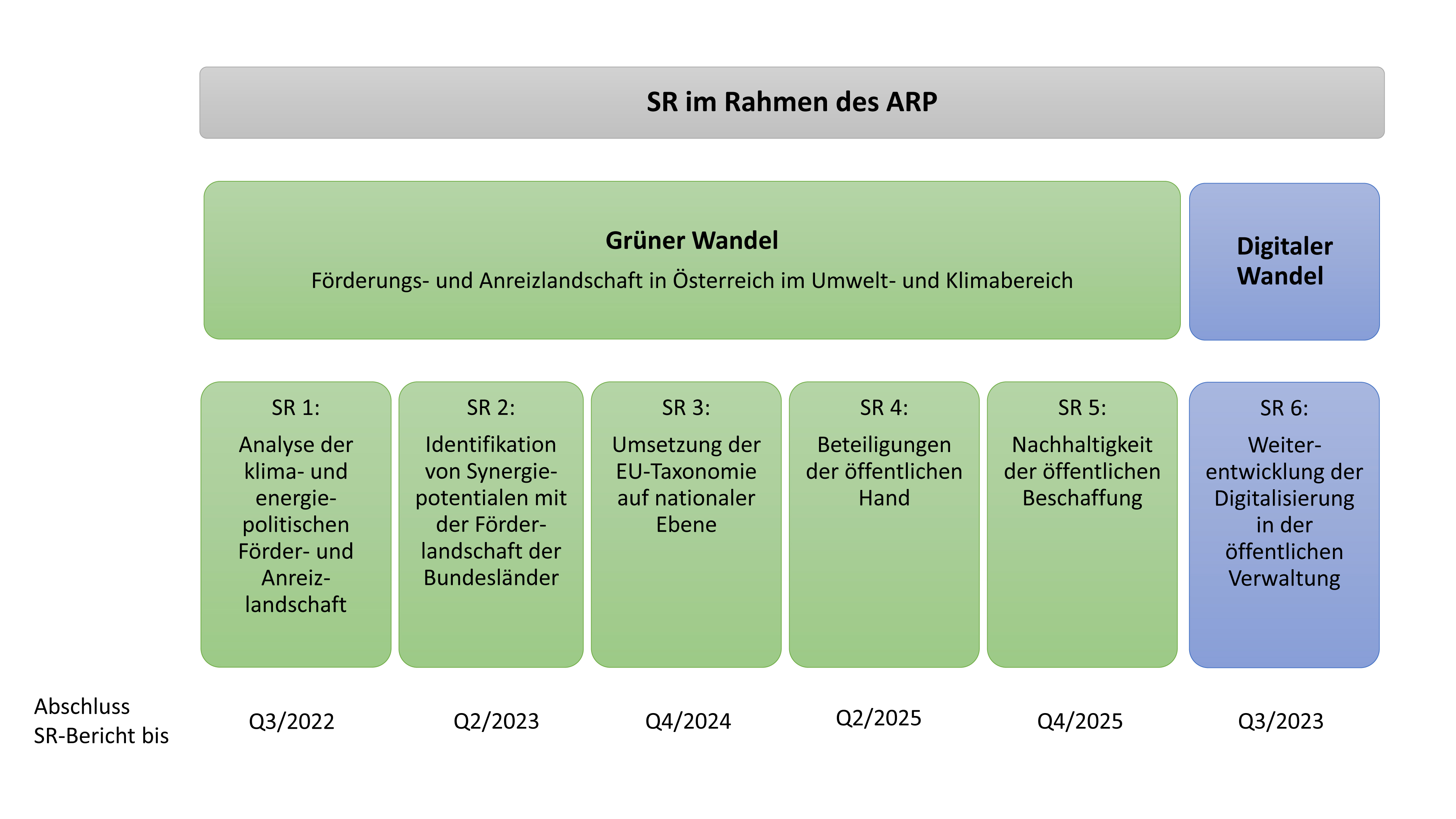Green spending reviews of the Federal Ministry of Finance
Already since 2016, Spending Reviews, which are structured budget analyses, have been regularly made use of in Austria as an essential contribution in identifying potential savings, but also to ensure efficient and effective administration. In doing so, clear framework conditions are established that focus on budgetary consolidation as a priority of the Federal Government, highlight the importance of strategic, fact-based decisions, and emphasise the need for relevant information for budgetary decisions.
Spending Review in the context of the Austrian Recovery and Resilience Plan
The Austrian Recovery and Resilience Plan (RRP) (PDF, 1 MB), which was created as part of the European Recovery and Resilience Facility, includes "Spending Reviews" as a reform priority, among others. The background of the obligation for conducting this Spending Review cycle is one of the four key points of focus in the national Recovery and Resilience Plan, which pursues sustainable recovery, including a focus on aspects such as the green finance agenda. This priority has been taken into account in Austria through the introduction of a green budgeting focal point in the budget section of the Federal Ministry of Finance, with the aim of improving consideration of ecological aspects in the budgetary process. The long-term goal is to conduct an overall systemic analysis of all the sovereign activities of the federal government and to examine their compatibility with climate change mitigation and environmental protection.
The reform, which has been ongoing since the end of 2021, consists of five modules that build on each other and focus on "green transformation", as well as one on the topic of "digital transformation".
In the first module of the Spending Review cycle, an "analysis of the subsidy and incentive landscape with regard to climate and energy policies" is set to be carried out. The aim is to examine the cost-effective use of funds and the efficient use of the existing levers of the public sector to achieve the environmental and climate goals.
Building on this, additional reports are to be carried out by 2025 on the topics of potential for synergies in the subsidy landscape of the federal provinces, implementation of the EU Taxonomy, public authorities' involvement with regard to the national energy and climate plan and sustainability of public procurement. The Spending Review in the context of the "digital transformation" is planned after the roll-out of the measures of the Digitalisation Fund.
context of the "digital transformation" is planned after the roll-out of the measures of the digitalisation fund.

Module 1: Green finance flows in the federal budget
Module 1 of the Spending Review cycle focuses on the subsidy and incentive landscape with regard to climate and energy policies at the federal level. The aim is to examine the cost-effective use of funds and the efficient use of existing levers of the public sector to achieve the environmental and climate goals.
The task described and the associated importance of focusing on the impact of measures and deployed budgetary resources requires a systemic approach. The categorisation of climate-specific and environmental-specific inpayments and outpayments respectively revenues and expenditures, is complex and can follow various approaches.
The Federal Ministry of Finance applies the following working definition: Climate-specific and environmental-specific inpayments and outpayments respectively revenues and expenditures, cover all climate-specific and environmental-specific inpayments and outpayments, or revenue and expenditure, that make a positive contribution to compliance with national, EU and/or international climate and environmental targets. A clear distinction must be made between financial resources associated with public measures whose effects counteract compliance with the climate and energy targets that are binding under national, EU and/or international law. This definition includes, for example, measures with counterproductive incentives and subsidies that result in:
- increased greenhouse gas emission levels,
- a reduction of the share of renewable energy in the gross final energy consumption, and/or
- a reduction in energy efficiency. (See national energy and climate plan (NEKP), only in German)
Responsibility
The Spending Review cycle in the context of the Austrian Recovery and Resilience Plan is supervised by the staff division of the budget section of the Federal Ministry of Finance. Various specialist staff develop the contents of the thematically structured modules.
Documents
Spending Review Modul 1: Klima- und Energie (BMF Klimateam) (PDF, 4 MB)(only in german)